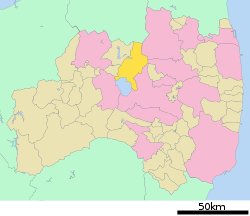Inawashiro
| Inawashiro 猪苗代町 | |||
|---|---|---|---|
| Town | |||
 View of Inawashiro Lake from Mount Bandai | |||
| |||
 Location of Inawashiro in Fukushima Prefecture | |||
 Inawashiro | |||
| Coordinates: 37°34′28″N 140°07′17″E / 37.57444°N 140.12139°ECoordinates: 37°34′28″N 140°07′17″E / 37.57444°N 140.12139°E | |||
| Country | Japan | ||
| Region | Tōhoku | ||
| Prefecture | Fukushima Prefecture | ||
| District | Yama District | ||
| Area | |||
| • Total | 395.00 km2 (152.51 sq mi) | ||
| Population (September 2014) | |||
| • Total | 15,011 | ||
| • Density | 38/km2 (100/sq mi) | ||
| Time zone | UTC+9 (Japan Standard Time) | ||
| - Tree | Sorbus commixta | ||
| - Flower | Habenaria radiata | ||
| - Bird | Swan | ||
| Phone number | 0242-62-2111 | ||
| Address | Jonan 100, Inawashiro-machi, Yama-gun, Fukushima-ken 969-3123 | ||
| Website | http://www.town.inawashiro.fukushima.jp/ | ||
Inawashiro (猪苗代町 Inawashiro-machi) is a town located in Fukushima Prefecture, Japan. As of September 2014, the town had an estimated population of 15,011, and a population density of 38 persons per km². The total area is 395.00 km². It is noted as the birthplace of the famous doctor Hideyo Noguchi, who contributed to knowledge in the fight against syphilis and yellow fever.[1]
Geography
Inawashiro is located in the far north of the Aizu region of Fukushima Prefecture, bordering Yamagata Prefecture to the north and Lake Inawashiro to the south. The climate is like many other parts of northern Japan, with cold winters and snowfall averaging 2 meters.
- Mountains : Mount Bandai, Mount Adatara, Mount Azuma-kofuji
- Rivers : Nagase River
- Lakes : Lake Inawashiro, Akimoto Lake
Neighboring municipalities
History
The area of present-day Inawashiro was part of ancient Mutsu Province and the location of Inawashiro Castle since the Kamakura period. It was the site of the Battle of Suriagehara during the Sengoku period. The area formed part of the holdings of Aizu Domain during the Edo period. During the Boshin War, the Battle of Bonari Pass took place near Inawashiro. After the Meiji Restoration, the area was organized as part of Yama District. The modern town of Inawashiro was founded with the establishment of the municipalities system on April 1, 1898. The town borders expanded considerably in 1955 through a merger with the villages of Iwase, Iwaho, Azauma, Nagase, Tsukinowa, Chisato, and Okinajima.
Economy
The economy of Inawashiro is based on agriculture and tourism. There are many ski resorts, onsen and leisure facilities at Lake Inawashiro. Sulfur mining, formerly a mainstay of the local economy into the mid-Showa period, ended with the closure of the last mine in 1968.
Transportation
Railway
- JR East – Ban'etsu West Line
- Jōko - Sekito - Kawageta - Inawashiro - Okinashima
Highway
- Ban-etsu Expressway – Inawashiro-Bandai Kogen IC
- Bandai-Azuma Roadway
- Japan National Route 49
- Japan National Route 115
Local attractions
- Tenkyōkaku, a Meiji-period former residence of Prince Arisugawa Takehito, designated an Important Cultural Property
- Noguchi Hideyo Memorial Hall
Noted people from Inawashiro
- Hideyo Noguchi - bacteriologist
- Yumeko Aizome - actress
References
External links
![]()
- Official Website (in Japanese)
